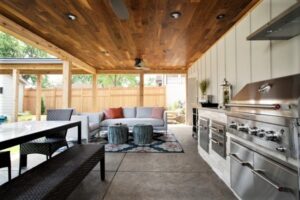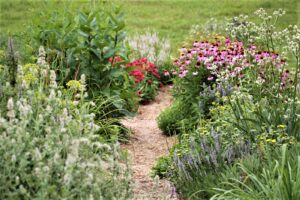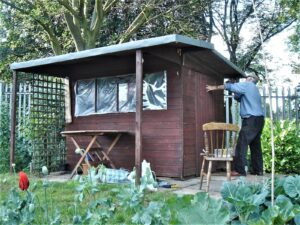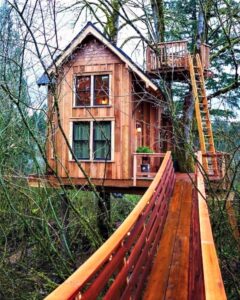BY DEBRA KEEFER RAMAGE

Castle Remodeling, bringing the indoors outdoors
This issue of No Place Like Home is going to discuss sustainability, building on the themes raised for Earth Day last month. Most of the suggestions here apply mostly to homeowners, but if you’re a renter, you can try to get your property owner or manager onboard to do them, possibly by organizing fellow tenants if you’re in a multi-unit building. If you’re in a single-family unit that’s your landlord’s only (or one of few) properties, they ought to be amenable, since many of the ideas around sustainability also save money in the long run.
The word “sustainable” has become a buzzword to the corporate world. It’s often used as a simple substitute for “meanness” in the ancient form of that word, i.e., being overly reluctant to spend money or energy. To “sustain” is to nourish and promote healthy growth. The essence of sustainability is where something is nurtured and grows just enough to keep the organism or system healthy, but not out of control.
It’s an ideal thing to aspire to, in your individual home, or your planetary home. So the building, replacing, spending and growing should be careful and balanced, not just restrained and denied.
In the interest of balance, we have divided your home into its outdoors and its indoors, and then we’ll consider sustainable practices, choices and improvements for the various elements comprising each.
Outdoors

Grow your own medicine.
Probably the most sustainable thing you can do outside your home is have less lawn. Lawns don’t contribute to carbon-storage, and they often require harmful chemical inputs to “maintain.” If you ruthlessly destroy all the natural flowering weeds, you are taking something useful out of the system, often at great and wasteful expense. If you really especially like lawns, you might consider having a small one, as a treat.
The obvious and best alternative to a lawn is to devote as much land as practical to growing things that you can eat, or use, or that store carbon well and provide shade and beauty at the same time. So, gardening. Vegetable gardening, which includes a few ground-dwelling fruits, flower gardening, and herb gardening.
In my opinion, herb gardening is not only the highest use you can put your land to, but also a great investment of time and knowledge. Herbs are as beautiful as flowers, many of them are as edible as vegetables and fruits, and they often have side benefits, like enriching the soil, repelling pests, or attracting pollinators.
When you start studying about herbs for the purpose of growing them, you learn how arbitrary these labels are. Take sorrel. Is that an herb or a vegetable? Dandelion—weed or herb? To one trying to make a perfect lawn, it’s a noxious weed, but then the co-op is selling dandelion extract at $15 per ounce. It makes you think. Good gardening centers like Mother Earth Gardens have book sections where you can gain a wealth of knowledge: mother-earth-gardens-webstore.myshopify.com/collections/books.
Flower gardening may seem like an unsustainable practice at first glance, but it’s still superior on several levels to growing lawn. No matter how beautiful your lawn, though, the flowers bordering it and maybe taking it over are more beautiful still, with fewer inputs. If you like cut flowers in your indoor decor, growing them yourself saves a ton of excess carbon, a few bucks per bouquet, and gives you a glow of accomplishment and satisfaction. Also, some flowers, such as marigolds and morning glories, make good companion plants in your kitchen garden.
There are lots of “niche” garden styles for various specific purposes. A rain garden consists of water-loving, and attractive, plantings in a low spot in your garden, and helps to control floods and pools that might breed mosquitos or kill other plants, including grass and even trees. A rock garden is good for a sunny spot with poor soil. A pollinator garden is specifically designed to attract and nourish bees, butterflies and other pollinating little critters.

English gardener and allotment shed
Vegetable gardening’s benefits are so obvious, what do we need to say? What if you’re just not a good gardener, though? You may have issues of age, mobility, or even time that make you hesitate to start a garden that might end up badly. Here’s an idea—hire someone else to do the work you can’t do. Or, how about a swap, a cooperative agreement, or even urban sharecropping, where you provide the land and money, they provide the labor, and you agree ahead of time on a fair division of the output?
Some investment of technology may help overcome personal limitations, or environmental ones. For instance, older people may build raised beds or use straw-bale gardening techniques. Cold frames or small greenhouses can extend the growing season and the range of things you can grow. An irrigation system can make watering easier and more regular. There are so many home irrigation providers in the Twin Cities! They are mostly designed for huge lawns, but I’m sure some of them can provide for a gardener as well.
Which brings us to the subject of water. Here, in most of the U.S., water scarcity is not a big problem yet. But we still pay for water, and it’s not inexhaustible. The use of rain barrels is a very sustainable practice which is catching on here. (In England, where I used to live, it was absolutely de rigeur.) Another piece of water conservation is preventing stormwater runoff pollution. We have an excellent watershed management organization in our local government where you can get thorough information on doing your part. If you’re in the Minnehaha Creek Watershed District, like much of South Minneapolis, check out their website at www.minnehahacreek.org, or search the internet for other organizations.

Grown-up treehouses are very in this year.
Also, within the purview of outdoors are recreation equipment, trees and outbuildings, including garages, decks and patios. I am a big fan of the shed. In most European countries, almost every home has a shed. Allotments, similar to community gardens, allow plot holders to install a shed on their allotment, and gardeners (mostly men) hang out there all day.
Unless your garage is huge and your yard is tiny, consider adding a shed, a greenhouse, or some other useful outbuilding to your life.
Decks and patios can be considered like outbuildings, but open to the sky. I think decks are slightly more sustainable than patios, which are, after all, not that different from pavement. But either way, you can put large containers of plants on them for a slightly beneficial carbon effect. For a new deck, be sure to choose sustainable and fairly-traded materials to build and furnish it.
If you like to cook outdoors, consider a solar oven instead of a barbecue or gas cooker. Consider something more sustainable than a wood fire as a focus for evenings outdoors and forgo the fire pit or bonfire. Use strings of lights in the trees and a few solar lamps, for instance.
And finally, trees. Have as many trees on your land as it can sensibly support. Consult a tree expert for best practices, safety and a lifecycle plan for your trees. The earth is desperately short of trees!
Indoors

Natural materials kitchen from Minneapolis Granite
The sustainable principle here is to always have a reason for a building project, a renovation, an enhancement or a new purchase. Most of us just have too much stuff, and we need to find a way to slow our consumption, and thus our production, without creating want. Part of that is not consuming for its own sake.
Start by visualizing your home as an ideal of efficiency, sustainability, comfort and beauty. Make a plan before you buy or contract for services, and make sure that every choice is moving you toward your vision.
What most people spend the most money and energy on improving is either their kitchen or their bathroom, probably more so the kitchen. Kitchens are the big energy hogs of the home, besides heating and cooling systems, so this makes sense. You can get this same information from a good contractor, if you’re using one for your renovation, and we do have contractors in our city that specialize in “green” building practices and sustainability. But in case you’re a DIY person, here are some thoughts to get you started:
• Light – the more natural light, the less energy use. Also good for kitchen window herbs and microgreens.
• Herbs and microgreens – grow indoors to extend your output (and also as utilitarian decor).
• Energy-efficient appliances – pretty obvious.
• Sustainable materials for floors, countertops, backsplash, storage.
• Low VOC, less toxic paints.
• Water filtration system to replace buying bottled water for drinking, etc.
• Dishwashers save water and energy if you are a two-plus person household, but maybe not for a single person household.
• Multi-use appliances such as a microwave, pressure cooker or food processor save on production and transportation costs to the environment.
• Use “Buy Nothing” pages on Facebook (most South Minneapolis neighborhoods have one) or other sharing economy networks to give away and acquire, before you discard or purchase new.
• Garbage – have a recycling plan and station, and also a home composting system if possible. Consult the many resources on reducing waste. Use bfy.tw/Qr13.
• Water – water your houseplants with leftover non-polluted water. And don’t waste it. Don’t leave the tap running if the water’s not being used. If you wash dishes by hand, wash as many as possible before discarding water.
A lot of the same ideas apply to the rest of your home. Here’s a list of some more ideas:
• Use window coverings to control temperature, such as cellular shades, quilted drapes, room-darkening blinds.
• Your heating and cooling system is the other high energy consumer in your home. Consider smart thermostats, solar items, small personal coolers, humidifying and/or dehumidifying. Upgrading to central air will save over time.
• Or just bite the bullet and go solar. A lot of people have decided it’s now time. (Hooray for you if you do it! But don’t think that gives you a pass on everything else.)
• Use water-saving technology in your bathroom and laundry too.
• Although it’s nice to have a wood fire in a fireplace indoors or a fire pit outside, it’s still contributing to global warming and carbon release. Consider reducing wood and gas fires as much as possible by eating more raw foods, using a solar cooker, and not having a fire indoors in your fireplace.
• Use non-toxic or less toxic products everywhere! Things don’t just disappear from the ecosystem when you put them down the drain or in the trash.
• Make sure furniture purchases are sustainable materials and fair-trade. (Fair-trade is especially important for imported rugs, which may be produced by child labor.)
I hope this has given you some good ideas on how to improve your home environment and the surrounding plane-tary environment at the same time. South Minneapolis is teeming with better experts than me, so find one and get the information you need.























